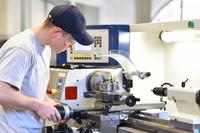Rory Cooper first became interested in tinkering and engineering as a young Eagle Scout in California, which is not unexpected for a boy who grew up in a family of machinists in Los Angeles.
Like many veterans, he would join the military not just to serve his country, but to start his adult life, to travel and eventually go to college. Army life taught him that service is about more than benefits. An accident during his service would propel him to use his education to help disabled people the world over.
Cooper joined the Army in 1976, assigned to work in artillery as an armorer in West Germany. He learned German to become a linguist and was assigned to the Signal Corps. Later, he served on the staff of Maj. Gen. C.E. McKnight. It was during this time in West Germany that he was struck by a bus while riding a bicycle, and the damage to his spinal cord in the accident left him paralyzed from the waist down.
From that moment on, his life was forever changed. His injury may have been the catalyst for that change, but it was only the beginning. With encouragement from McKnight, Cooper pursued a degree in electrical engineering from California Polytechnic State University.
"After my injury, I had to plot a new course in life," Cooper told the Department of Veterans Affairs. "I don't think that it matters anymore. I've found my calling, and I have a rewarding life that is filled with the love of family and friends and is professionally fulfilling. I hope that my professional and volunteer work has and is making a positive difference in the lives of Veterans and people with disabilities.

At 20 years old and otherwise healthy and fit, Cooper had a few problems with being in a wheelchair, even though they were state of the art for the time. While on campus in California, maneuvering the 80 pounds of chrome and steel frustrated him. They were heavy, unwieldy and difficult to push.
As he studied, he put his new skills to work in his family's machinist workshop, creating a lighter, more maneuverable wheelchair for himself. His innovations would lead to his new career and a lot of positive advances in wheelchair technology.
He graduated with a bachelor's and a master's degree in electrical engineering in 1985 and 1986, respectively. By 1989, he earned a doctorate in electrical and computer engineering from the University of California, Santa Barbara. Having solved the problem of his own wheelchair, he set out to improve the lives of others. Wheelchair users at the time suffered from repetitive stress injuries, just from the daily grind of getting around.
To begin his work in addressing the problem, he co-founded the Human Engineering Research Laboratories (HERL), a partnership between the University of Pittsburgh and the VA. He received a $3.5 million grant to study and improve the design and safety of wheelchairs. In the years since, he's filed for dozens of patents that have significantly improved the quality of life for veterans and disabled people in the United States and beyond.
For starters, his lab's findings resulted in a new pushrim that fit a human palm and featured a thumbslot for manual propulsion. A new design and advanced coatings also made it easier to get moving with less force and hit the brakes more efficiently. Users reported less pain and fewer injuries to their hands, arms and shoulders in the years that followed.
For those with more complex injuries who were using automatic wheelchairs, HERL created a new digital joystick that could sense the pressure applied by the user. It could also be tailored to an individual's condition, based on how much function they had in their hands and arms. It even accounted for hand tremors.
"Now, the idea is that a wheelchair is more like a shoe than a sofa," he told the Pittsburgh Post-Gazette in 1998. "Wheelchairs are a lot more personalized than they used to be."

Today, Cooper continues his work in the Human Engineering Research Laboratories and is the author of two books: "Rehabilitation Engineering Applied to Mobility and Manipulation" and "Wheelchair Selection and Configuration." He's also co-authored a number of other books related to his field.
Cooper is also an active athlete, competing in adaptive sports competitions all over the world. He won a bronze medal at the 1988 Seoul Paralympics in the 4×400-meter wheelchair relay and more than 200 medals in the National Veterans Wheelchair Games. In 2023, he was inducted into the National Inventors Hall of Fame.
"It is tremendously rewarding to help make life better for Veterans," Cooper said in his VA interview. "I get a great feeling to see a Veteran using something that HERL invented or to hear a VA clinician talk about how our research has helped his or her Veteran patients. It is the basis for my work. ... Enabling their lives is my reward."
-- Blake Stilwell can be reached at blake.stilwell@military.com. He can also be found on Twitter @blakestilwell or on Facebook.
Want to Know More About Veteran Jobs?
Be sure to get the latest news about post-military careers as well as critical info about veteran jobs and all the benefits of service. Subscribe to Military.com and receive customized updates delivered straight to your inbox.












